 Model boat plans are more difficult to come
by than model airplane plans, so seeing this article in the August 1954 issue of
Air Trails magazine for a small, free-running hydroplane was a nice find.
Its simple, inexpensive construction makes it a quick build for those rare modelers
that still build their own models out of wood. The Skiddin' II can easily accommodate
a modern miniature radio control system and a brushless motor setup. The original
model was designed for a transom-mounted glow fuel outboard engine, but those things
make model boat plans look plentiful. If you really want an outboard, try eBay,
and be prepared to pay a couple hundred bucks for it...
Model boat plans are more difficult to come
by than model airplane plans, so seeing this article in the August 1954 issue of
Air Trails magazine for a small, free-running hydroplane was a nice find.
Its simple, inexpensive construction makes it a quick build for those rare modelers
that still build their own models out of wood. The Skiddin' II can easily accommodate
a modern miniature radio control system and a brushless motor setup. The original
model was designed for a transom-mounted glow fuel outboard engine, but those things
make model boat plans look plentiful. If you really want an outboard, try eBay,
and be prepared to pay a couple hundred bucks for it...
 In the late 1960s when I received a Cox
Sky Copter free flight helicopter for Christmas, there was very little in the way
of commercially available flying model helicopters. It was modeled after the Bell
47−G, which was later made famous by the M.A.S.H. television series. Victor Stanzel
sold its tethered ElectroMic "Copter" that was powered by a pair of "D" cell batteries.
As far as I know, Cox made the only nitro fuel powered free flight helicopter, named
"Sky Copter." It was powered by a Cox .020 engine mounted to the top-center of the
main rotor shaft, and caused the rotors to turn due to the counter torque cause
by the propeller on the .020. It worked very well. After getting the engine started,
you would give the rotors a spin in the clockwise direction (looking down from the
top), and the gently push the model straight up. My guess is that most of the lift
was provided by the engine's propeller pushing air down, and that the spinning rotors
served primarily to stabilize the model during powered flight. Once the engine quit,
the spinning rotors essentially went into a counter-rotation mode to gently bring
the Sky Copter back to terra firma...
In the late 1960s when I received a Cox
Sky Copter free flight helicopter for Christmas, there was very little in the way
of commercially available flying model helicopters. It was modeled after the Bell
47−G, which was later made famous by the M.A.S.H. television series. Victor Stanzel
sold its tethered ElectroMic "Copter" that was powered by a pair of "D" cell batteries.
As far as I know, Cox made the only nitro fuel powered free flight helicopter, named
"Sky Copter." It was powered by a Cox .020 engine mounted to the top-center of the
main rotor shaft, and caused the rotors to turn due to the counter torque cause
by the propeller on the .020. It worked very well. After getting the engine started,
you would give the rotors a spin in the clockwise direction (looking down from the
top), and the gently push the model straight up. My guess is that most of the lift
was provided by the engine's propeller pushing air down, and that the spinning rotors
served primarily to stabilize the model during powered flight. Once the engine quit,
the spinning rotors essentially went into a counter-rotation mode to gently bring
the Sky Copter back to terra firma...
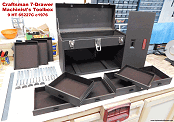 Early in 1982, fresh out of the USAF as
an Air Traffic Control Radar Repairman, I was fortunate to land a job as an electronics
technician at the Oceanic Division of Westinghouse in Annapolis, MD. It turned out
being more of a high level electronics assembly job building printed circuit boards,
chassis, wire harnesses, sonar transducers, and integrated systems, mostly for the
U.S. Navy. A fairly extensive collection of high quality hand tools were required
in order to get results which would pass rigorous Navy inspection standards. Snap-On
was the supplier of choice because at the time they made extremely high quality
(and expensive) small pliers, wire cutters, screwdrivers, wrenches, nuts drivers,
etc. I don't know whether there are still roaming Snap-On tool trucks visiting businesses
anymore, but at the time we got a weekly visit. Onboard was a tool refiguring workbench
for sharpening cutters, repairing screwdriver tips, and other things. Restored components
of the c1976
Craftsman 7−Drawer Machinist's Tool Chest. Craftsman 7−Drawer Machinist's Toolbox
- top open. Cleaned and groomed felt surfaces...
Early in 1982, fresh out of the USAF as
an Air Traffic Control Radar Repairman, I was fortunate to land a job as an electronics
technician at the Oceanic Division of Westinghouse in Annapolis, MD. It turned out
being more of a high level electronics assembly job building printed circuit boards,
chassis, wire harnesses, sonar transducers, and integrated systems, mostly for the
U.S. Navy. A fairly extensive collection of high quality hand tools were required
in order to get results which would pass rigorous Navy inspection standards. Snap-On
was the supplier of choice because at the time they made extremely high quality
(and expensive) small pliers, wire cutters, screwdrivers, wrenches, nuts drivers,
etc. I don't know whether there are still roaming Snap-On tool trucks visiting businesses
anymore, but at the time we got a weekly visit. Onboard was a tool refiguring workbench
for sharpening cutters, repairing screwdriver tips, and other things. Restored components
of the c1976
Craftsman 7−Drawer Machinist's Tool Chest. Craftsman 7−Drawer Machinist's Toolbox
- top open. Cleaned and groomed felt surfaces...
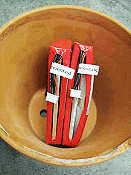 Lightweight
lithium
ion polymer (Li-Poly) batteries have made a huge impact on the performance,
and subsequently the acceptance of electric systems as a replacement for the traditional
nitromethane (nitro) and gasoline power systems in model airplanes and helicopters.
Their energy density (Wh/kg is the most common unit of measure), combined with the
relatively new and extremely powerful brushless motors, electric power systems are
rivaling the internal combustion systems in terms of both energy and duration. Development
of both the brushless motors and the advanced battery technologies has been, both
officially and unofficially, a joint venture between government and civilian research
and development efforts. If you keep up with the news headlines for NASA, defense
contractors, green energy researchers, and similar organizations, you have witnessed
the plethora of new vehicles that have been built tested, and in may cased deployed
in the field. These range from micro air vehicles that carry surveillance equipment
for the military, to hybrid and fully electric passenger vehicles, vastly improved...
Lightweight
lithium
ion polymer (Li-Poly) batteries have made a huge impact on the performance,
and subsequently the acceptance of electric systems as a replacement for the traditional
nitromethane (nitro) and gasoline power systems in model airplanes and helicopters.
Their energy density (Wh/kg is the most common unit of measure), combined with the
relatively new and extremely powerful brushless motors, electric power systems are
rivaling the internal combustion systems in terms of both energy and duration. Development
of both the brushless motors and the advanced battery technologies has been, both
officially and unofficially, a joint venture between government and civilian research
and development efforts. If you keep up with the news headlines for NASA, defense
contractors, green energy researchers, and similar organizations, you have witnessed
the plethora of new vehicles that have been built tested, and in may cased deployed
in the field. These range from micro air vehicles that carry surveillance equipment
for the military, to hybrid and fully electric passenger vehicles, vastly improved...
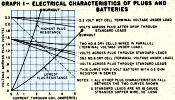 As with most aspects of every type of hobby,
there is a plethora of different types of
glow plugs available for your selection. The same goes for engines in which
to use them. The quandary that haunts many modelers is which glow plug is the best
for a certain engine, fuel, ambient temperature, altitude, etc. In the April 2012
edition of Model Aviation magazine, Bob Aberle addressed just that topic
and provided a website for an extensive treatise on glow plug specifications and
usages. In it James McCarty, Brian Cooper, and Brian Gardner list the major glow
plug manufacturers and present voltages, heat ranges, applications, intended fuel
nitro content, short versus long, idle bar, etc. Fifty years earlier, William Netzeband
published an extensive article in the 1963 Annual Edition of American Modeler
magazine that employs a very methodical and scientific approach that resulted in
extensive graphs and tables that are still largely applicable to today's equipment...
As with most aspects of every type of hobby,
there is a plethora of different types of
glow plugs available for your selection. The same goes for engines in which
to use them. The quandary that haunts many modelers is which glow plug is the best
for a certain engine, fuel, ambient temperature, altitude, etc. In the April 2012
edition of Model Aviation magazine, Bob Aberle addressed just that topic
and provided a website for an extensive treatise on glow plug specifications and
usages. In it James McCarty, Brian Cooper, and Brian Gardner list the major glow
plug manufacturers and present voltages, heat ranges, applications, intended fuel
nitro content, short versus long, idle bar, etc. Fifty years earlier, William Netzeband
published an extensive article in the 1963 Annual Edition of American Modeler
magazine that employs a very methodical and scientific approach that resulted in
extensive graphs and tables that are still largely applicable to today's equipment...
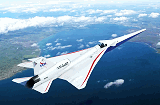 "NASA's X-59 aircraft, capable of supersonic
flight while reducing sonic booms to quieter 'thumps,' has been moved for testing
in California. The collected data on human reactions to supersonic noise will potentially
assist in enabling commercial supersonic flight over land. The following series
of images shows NASA’s X-59 as it sits on the flight line - the space between the
hangar and the runway - at Lockheed Martin Skunk Works in Palmdale, CA, on June
19, 2023. The move from its construction site to the flight line is one of many
milestones that prepare the X-59 for its first and subsequent flights. Next up,
the team will conduct significant ground tests to ensure the aircraft is safe to
fly. The X-59 aircraft - the centerpiece of NASA’s Quesst mission - is designed
to demonstrate the ability to fly supersonic, or faster than Mach 1, while reducing
the loud sonic boom to a quiet sonic thump. NASA will then fly the X-59 over several
communities to gather data on human responses to the sound generated during supersonic
flight..."
"NASA's X-59 aircraft, capable of supersonic
flight while reducing sonic booms to quieter 'thumps,' has been moved for testing
in California. The collected data on human reactions to supersonic noise will potentially
assist in enabling commercial supersonic flight over land. The following series
of images shows NASA’s X-59 as it sits on the flight line - the space between the
hangar and the runway - at Lockheed Martin Skunk Works in Palmdale, CA, on June
19, 2023. The move from its construction site to the flight line is one of many
milestones that prepare the X-59 for its first and subsequent flights. Next up,
the team will conduct significant ground tests to ensure the aircraft is safe to
fly. The X-59 aircraft - the centerpiece of NASA’s Quesst mission - is designed
to demonstrate the ability to fly supersonic, or faster than Mach 1, while reducing
the loud sonic boom to a quiet sonic thump. NASA will then fly the X-59 over several
communities to gather data on human responses to the sound generated during supersonic
flight..."
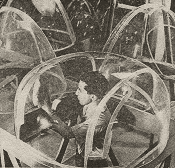 Of course the allusion in this title, "'The
Better to See With...'
Plexiglas Machine Gun Turrets" is to "Little Red Riding Hood." Do you remember
the scene in "It's a Wonderful Life" where Sam Wainright's new factory has a busy
production line turning our Plexiglas canopies? "I have a big deal coming up
that's going to make us all rich. George, you remember that night in Martini's bar
when you told me you read someplace about making plastics out of soybeans?" George
passed it up and Sam got rich. Plastics were rarely found in products prior to World
War II. A shortage of metal, glass, and rubber (recall the surplus materials
collections) gave birth to a thriving plastics industry that included aircraft canopies.
Prior to that, you will note the flat glass window panes used in windshields and
canopies built in segments using metal frames. The one photo of the line worker
applying a coat of Simoniz to the Plexiglas canopy reminds me of the company's slogan
"Motorists wise, Simoniz," which was made famous again in the original story version
of "A Christmas Story," by Gene Shepherd, entitled "Duel in the Snow, or Red Ryder
Nails the Cleveland Street Kid."
Of course the allusion in this title, "'The
Better to See With...'
Plexiglas Machine Gun Turrets" is to "Little Red Riding Hood." Do you remember
the scene in "It's a Wonderful Life" where Sam Wainright's new factory has a busy
production line turning our Plexiglas canopies? "I have a big deal coming up
that's going to make us all rich. George, you remember that night in Martini's bar
when you told me you read someplace about making plastics out of soybeans?" George
passed it up and Sam got rich. Plastics were rarely found in products prior to World
War II. A shortage of metal, glass, and rubber (recall the surplus materials
collections) gave birth to a thriving plastics industry that included aircraft canopies.
Prior to that, you will note the flat glass window panes used in windshields and
canopies built in segments using metal frames. The one photo of the line worker
applying a coat of Simoniz to the Plexiglas canopy reminds me of the company's slogan
"Motorists wise, Simoniz," which was made famous again in the original story version
of "A Christmas Story," by Gene Shepherd, entitled "Duel in the Snow, or Red Ryder
Nails the Cleveland Street Kid."
 Those of us fortunate (or unfortunate, depending
on your point of view) to have been in the model airplane realm back in the 1960s
and 1970s (and earlier) are very familiar with Maxey Hester and his award-winning
models. Mr. Hester designed many of the fine scale models sold (some still) by Sig
Manufacturing of Montezuma, Iowa. In fact, if you don't know, Maxey later married
Hazel Sigafoose after her first husband and company co-founder (Glen) died (during
an aerobatic performance). This
P−63
Kingcobra was designed for "multi" radio (what we refer today as 4 or 5 channels)
and a K&B .45 engine. The wingspan is about 64".
Those of us fortunate (or unfortunate, depending
on your point of view) to have been in the model airplane realm back in the 1960s
and 1970s (and earlier) are very familiar with Maxey Hester and his award-winning
models. Mr. Hester designed many of the fine scale models sold (some still) by Sig
Manufacturing of Montezuma, Iowa. In fact, if you don't know, Maxey later married
Hazel Sigafoose after her first husband and company co-founder (Glen) died (during
an aerobatic performance). This
P−63
Kingcobra was designed for "multi" radio (what we refer today as 4 or 5 channels)
and a K&B .45 engine. The wingspan is about 64".
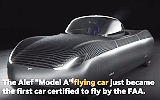 "A California-based company, Alef Aeronautics,
is building a
flying electric car that now has approval for testing. The company said the
Federal Aviation Administration (FAA) has granted it certification to begin testing
the car on the road and in the air, Fox Business reported Saturday. Although it
remains in the experimental phase, the company is taking preorders, according to
USA Today. The outlet also shared an image of the sleek, black vehicle called 'Model
A'. The low-speed fully electric car can be driven up to 200 miles on roadways and
also launch vertically into the air and boasts a flying range of 110 miles, the
Fox report said..."
"A California-based company, Alef Aeronautics,
is building a
flying electric car that now has approval for testing. The company said the
Federal Aviation Administration (FAA) has granted it certification to begin testing
the car on the road and in the air, Fox Business reported Saturday. Although it
remains in the experimental phase, the company is taking preorders, according to
USA Today. The outlet also shared an image of the sleek, black vehicle called 'Model
A'. The low-speed fully electric car can be driven up to 200 miles on roadways and
also launch vertically into the air and boasts a flying range of 110 miles, the
Fox report said..."
 The AirplanesAnd
The AirplanesAnd
Rockets.com website exists entirely on the support of its visitors by way of a small
percentage earned with your
Amazon.com purchases, which typically works out to less than
$10 per month. That barley covers the domain registration and secure server fees
for AirplanesAndRockets.com. If you plan to buy items via
Amazon.com, please click on this link to begin your shopping
session from here so that I get credit for it. Doing so does not cost you anything
extra. Thank you for your support.
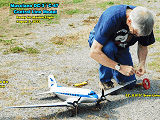 Breaking News!!! - My
electric-powered,
control line DC−3 model completed its maiden flight on August 2, 2023. It flew
beautifully! The lines kept nice and tight even with slight wind gusts. I was unsure
whether the motors and propellers would provide sufficient thrust, but 4−cell LiPo
battery, it will climb nearly straight up. In fact, though, the maiden flight only
used a 3-cell LiPo and it flew fine. The propellers are counter-rotating jobs meant
for a drone. They are the only 3−bladed props I could find that were small enough
in diameter with wide blades and high pitch. Allegheny Airlines livery was chosen
because of a photo I have of one sitting on the tarmac at Erie International Airport
sometime in the 1970s. A video will be posted soon...
Breaking News!!! - My
electric-powered,
control line DC−3 model completed its maiden flight on August 2, 2023. It flew
beautifully! The lines kept nice and tight even with slight wind gusts. I was unsure
whether the motors and propellers would provide sufficient thrust, but 4−cell LiPo
battery, it will climb nearly straight up. In fact, though, the maiden flight only
used a 3-cell LiPo and it flew fine. The propellers are counter-rotating jobs meant
for a drone. They are the only 3−bladed props I could find that were small enough
in diameter with wide blades and high pitch. Allegheny Airlines livery was chosen
because of a photo I have of one sitting on the tarmac at Erie International Airport
sometime in the 1970s. A video will be posted soon...
 These 4-level wooden bleacher plans are
the latest version. I was going to write up a hardware parts list, but never got
around to it. Both sections of the bleachers shown in the photo (built in fall of
2011) are still in service and are in excellent condition. Pressure treated lumber
was used for everything, and all the nuts, bolts, and washers are galvanized. Screws
for the planks are outdoor deck grade. Pressure treated landscaping timbers are
sitting on the ground between the soil and bleachers. My daughter sold the property
a couple years ago, so I don’t have access to it to take any other photos. My son-in-law
and I built both sections of bleachers in one weekend. Since many of the parts are
duplicates, we cut out and drilled the first of each type, then used them as templates
for the rest. If you have half a dozen people available to cut and drill, that will
speed the process considerably. We also built up the first seat/step frame, then
built the others on top of it to assure all were identical (using screws temporarily
so the bolts didn’t get in the way). Get the first one as perfect as possible. Prior
to erecting the entire assemblies, the ground area was leveled and the landscaping
timbers laid into position. We used long deck screws to hold them together to prevent
shifting during assembly. The completed bleachers will be as level as the foundation.
Adjustments can be made, if needed, with shims cut from the pressure treated wood.
Note that if the ground is wet/moist, the landscaping timbers will quickly begin
to bow upward as the wetter bottom expands...
These 4-level wooden bleacher plans are
the latest version. I was going to write up a hardware parts list, but never got
around to it. Both sections of the bleachers shown in the photo (built in fall of
2011) are still in service and are in excellent condition. Pressure treated lumber
was used for everything, and all the nuts, bolts, and washers are galvanized. Screws
for the planks are outdoor deck grade. Pressure treated landscaping timbers are
sitting on the ground between the soil and bleachers. My daughter sold the property
a couple years ago, so I don’t have access to it to take any other photos. My son-in-law
and I built both sections of bleachers in one weekend. Since many of the parts are
duplicates, we cut out and drilled the first of each type, then used them as templates
for the rest. If you have half a dozen people available to cut and drill, that will
speed the process considerably. We also built up the first seat/step frame, then
built the others on top of it to assure all were identical (using screws temporarily
so the bolts didn’t get in the way). Get the first one as perfect as possible. Prior
to erecting the entire assemblies, the ground area was leveled and the landscaping
timbers laid into position. We used long deck screws to hold them together to prevent
shifting during assembly. The completed bleachers will be as level as the foundation.
Adjustments can be made, if needed, with shims cut from the pressure treated wood.
Note that if the ground is wet/moist, the landscaping timbers will quickly begin
to bow upward as the wetter bottom expands...
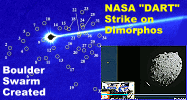
 For nearly two decades, a collaborative
effort between amateur and professional astronomers has been scanning the night
sky for massive bodies whose trajectories cross the Earth's orbital path, thereby
creating a potential collision someday. Software compares images of the entire sky
(acquired in small areas) to look for newly appearing and/or moving points of light.
As with amateur radio, which has contributed mightily to the knowledge of wireless
communications, so too have amateur astronomers significantly pioneered the field
(pun intended) of primarily visual wavelength astronomy. Indeed, they routinely
discover asteroids, planet and moon impacts by asteroids and meteorites, and even
novae missed by professionals. Panoramic Survey Telescope and Rapid Response System
(Pan-STARRS) does the heavy
lifting for finding near-earth objects (NEO), but NASA has a dedicated program called
Near-Earth Object Observations
(NEOO) Program. It includes devising methods to divert the trajectory of a massive
body capable of potentially devastating damage on impact. To do so, an explosion
is used to jolt the object enough to alter its orbit. It requires detection while
far enough away that a small nudge will create an acceptable margin of safety. NASA
recently tested its method on asteroid Dimorphos. Control room operators cheered
when the onboard camera show it making a direct hit. Score one for science.
It did alter the orbit, while also blowing off hundreds of smaller chunks, some
of which are now themselves NEO's, Oops. Q: Of all the asteroids out there,
why would they select one whose trajectory crosses Earth orbit, not knowing what
might happen if something went wrong? It took a rocket scientist to do that.
For nearly two decades, a collaborative
effort between amateur and professional astronomers has been scanning the night
sky for massive bodies whose trajectories cross the Earth's orbital path, thereby
creating a potential collision someday. Software compares images of the entire sky
(acquired in small areas) to look for newly appearing and/or moving points of light.
As with amateur radio, which has contributed mightily to the knowledge of wireless
communications, so too have amateur astronomers significantly pioneered the field
(pun intended) of primarily visual wavelength astronomy. Indeed, they routinely
discover asteroids, planet and moon impacts by asteroids and meteorites, and even
novae missed by professionals. Panoramic Survey Telescope and Rapid Response System
(Pan-STARRS) does the heavy
lifting for finding near-earth objects (NEO), but NASA has a dedicated program called
Near-Earth Object Observations
(NEOO) Program. It includes devising methods to divert the trajectory of a massive
body capable of potentially devastating damage on impact. To do so, an explosion
is used to jolt the object enough to alter its orbit. It requires detection while
far enough away that a small nudge will create an acceptable margin of safety. NASA
recently tested its method on asteroid Dimorphos. Control room operators cheered
when the onboard camera show it making a direct hit. Score one for science.
It did alter the orbit, while also blowing off hundreds of smaller chunks, some
of which are now themselves NEO's, Oops. Q: Of all the asteroids out there,
why would they select one whose trajectory crosses Earth orbit, not knowing what
might happen if something went wrong? It took a rocket scientist to do that.
 "The
327
was Cessna's solution to a downsizing opportunity. Then it ended up in a NASA
wind tunnel. Once upon a time, GA aircraft manufacturers pursued market niches with
the ferocity of wild dingos. When marketing teams identified a potentially underserved
customer segment, they wasted no time introducing minor variations to existing models
to accommodate it. Compared to today's offerings, the resulting variety of aircraft
was spectacularly broad and varied. When Cessna determined some customers would
be willing to pay a bit more for a slightly more powerful 172, for example, the
company introduced the 175 Skylark. This was little more than a 172 with a different
engine, but the company was in pursuit of new market segments and opted to advertise
it as an entirely different model. Similarly, Beechcraft identified markets for
both full-sized and smaller light twins in the forms of the Baron and Travel Air.
With four seats instead of five or six, thriftier 4-cylinder engines, and significantly
lighter weight..."
"The
327
was Cessna's solution to a downsizing opportunity. Then it ended up in a NASA
wind tunnel. Once upon a time, GA aircraft manufacturers pursued market niches with
the ferocity of wild dingos. When marketing teams identified a potentially underserved
customer segment, they wasted no time introducing minor variations to existing models
to accommodate it. Compared to today's offerings, the resulting variety of aircraft
was spectacularly broad and varied. When Cessna determined some customers would
be willing to pay a bit more for a slightly more powerful 172, for example, the
company introduced the 175 Skylark. This was little more than a 172 with a different
engine, but the company was in pursuit of new market segments and opted to advertise
it as an entirely different model. Similarly, Beechcraft identified markets for
both full-sized and smaller light twins in the forms of the Baron and Travel Air.
With four seats instead of five or six, thriftier 4-cylinder engines, and significantly
lighter weight..."
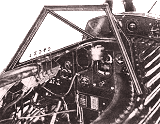 What
was considered in 1937 to be a breakthrough feat for a full-size airplane is today
accomplished regularly in model airplanes. What took hundreds of pounds of generators,
radio gear, sensors, and actuators to perform the first-ever
fully automatic landing is now done with a few ounces of microminiaturized GPS
receiver, processor, MEMS sensors, servos, and a LiPo battery. The HobbyZone Sportsman
S+RTF (see video at bottom) is an example. Most modern commercial aircraft are capable
of landing themselves in an emergency situation. Just today there was a news report
of an American Airlines pilot that died in flight and the copilot took over to land
the airplane; however, that Airbus A320 could have handled the job if necessary...
What
was considered in 1937 to be a breakthrough feat for a full-size airplane is today
accomplished regularly in model airplanes. What took hundreds of pounds of generators,
radio gear, sensors, and actuators to perform the first-ever
fully automatic landing is now done with a few ounces of microminiaturized GPS
receiver, processor, MEMS sensors, servos, and a LiPo battery. The HobbyZone Sportsman
S+RTF (see video at bottom) is an example. Most modern commercial aircraft are capable
of landing themselves in an emergency situation. Just today there was a news report
of an American Airlines pilot that died in flight and the copilot took over to land
the airplane; however, that Airbus A320 could have handled the job if necessary...
 Many moons ago I designed and built a combined
salt & pepper
and napkin holder for use on a round oak table we had when first married (1983).
It had a Lazy Susan turntable for the base to facilitate easy access by anyone sitting
at the table. At some point during our many household moves, we sold both the table
and the turntable at a yard sale. For a long time I have been planning to build
another to replace it. Finally, I used some leftover hickory wood from my Grandmother
clock project and built what you see here. It is about 11½" in diameter; the size
was kept as small as practical so as not to take up too much room on the table.
One improvement over the first iteration was only placing vertical supports near
the four corners, which keeps the back open for inserting napkins without needing
to remove the salt and pepper shakers...
Many moons ago I designed and built a combined
salt & pepper
and napkin holder for use on a round oak table we had when first married (1983).
It had a Lazy Susan turntable for the base to facilitate easy access by anyone sitting
at the table. At some point during our many household moves, we sold both the table
and the turntable at a yard sale. For a long time I have been planning to build
another to replace it. Finally, I used some leftover hickory wood from my Grandmother
clock project and built what you see here. It is about 11½" in diameter; the size
was kept as small as practical so as not to take up too much room on the table.
One improvement over the first iteration was only placing vertical supports near
the four corners, which keeps the back open for inserting napkins without needing
to remove the salt and pepper shakers...
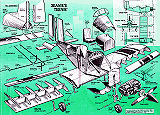 Using converted Volkswagen engines to power
boats, dune buggies, airplanes, water pumps, electricity generators, fans, and other
things was a popular meme in the 1960s. Hippies crashing their Bugs, Beetles, and
Vans while high on drugs made surplus engines readily available at a good price
($250, per this article, which is about $2,200 in 2023 money). The Evans Volksplane,
which began appearing in full-size aviation magazines sometime around 1968 or 1969,
was very popular. I thought it was in Popular Mechanics that I first saw it on the
cover, back in the day, but I cannot find it in a Google search. This "Flying
Volkswagen," unlike the Volksplane, looks pretty scary. It calls for piano hinges
on the control surfaces, and I'm thinking they were actual piano hardware rather
than certified flightworthy gear. The $600 project cost in 1968 is the equivalent
of around $5,300 today, which is about what a fully equipped radio controlled turbine-powered
jet model costs...
Using converted Volkswagen engines to power
boats, dune buggies, airplanes, water pumps, electricity generators, fans, and other
things was a popular meme in the 1960s. Hippies crashing their Bugs, Beetles, and
Vans while high on drugs made surplus engines readily available at a good price
($250, per this article, which is about $2,200 in 2023 money). The Evans Volksplane,
which began appearing in full-size aviation magazines sometime around 1968 or 1969,
was very popular. I thought it was in Popular Mechanics that I first saw it on the
cover, back in the day, but I cannot find it in a Google search. This "Flying
Volkswagen," unlike the Volksplane, looks pretty scary. It calls for piano hinges
on the control surfaces, and I'm thinking they were actual piano hardware rather
than certified flightworthy gear. The $600 project cost in 1968 is the equivalent
of around $5,300 today, which is about what a fully equipped radio controlled turbine-powered
jet model costs...
 "Scientists have developed a new method
to produce and shape large, high-quality mirrors,
significantly thinner than the primary mirrors traditionally employed in space
telescopes. These resultant mirrors possess enough flexibility to be rolled up and
packed efficiently within a spacecraft during launch. 'Launching and deploying space
telescopes is a complicated and costly procedure,' said Sebastian Rabien from Max
Planck Institute for Extraterrestrial Physics in Germany. 'This new approach - which
is very different from typical mirror production and polishing procedures - could
help solve weight and packaging issues for telescope mirrors, enabling much larger,
and thus more sensitive, telescopes to be placed in orbit..."
"Scientists have developed a new method
to produce and shape large, high-quality mirrors,
significantly thinner than the primary mirrors traditionally employed in space
telescopes. These resultant mirrors possess enough flexibility to be rolled up and
packed efficiently within a spacecraft during launch. 'Launching and deploying space
telescopes is a complicated and costly procedure,' said Sebastian Rabien from Max
Planck Institute for Extraterrestrial Physics in Germany. 'This new approach - which
is very different from typical mirror production and polishing procedures - could
help solve weight and packaging issues for telescope mirrors, enabling much larger,
and thus more sensitive, telescopes to be placed in orbit..."
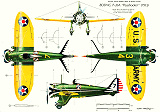 This 4-view for the
1933 Boeing
P−26A Peashooter was scanned from my purchased copy of the June 1968 American
Aircraft Modeler magazine. 4-view for this fine model was drawn by Mr. Björn Karlström.
All copyrights (if any) are hereby acknowledged. "The all-metal, single-wing P−26,
popularly known as the "Peashooter," was an entirely new design for Boeing, and
its structure drew heavily on the Monomail. The Peashooter's wings were braced with
wire, rather than with the rigid struts used on other airplanes, so the airplane
was lighter and had less drag. Its initial high landing speeds were reduced by the
addition of wing flaps in the production models...
This 4-view for the
1933 Boeing
P−26A Peashooter was scanned from my purchased copy of the June 1968 American
Aircraft Modeler magazine. 4-view for this fine model was drawn by Mr. Björn Karlström.
All copyrights (if any) are hereby acknowledged. "The all-metal, single-wing P−26,
popularly known as the "Peashooter," was an entirely new design for Boeing, and
its structure drew heavily on the Monomail. The Peashooter's wings were braced with
wire, rather than with the rigid struts used on other airplanes, so the airplane
was lighter and had less drag. Its initial high landing speeds were reduced by the
addition of wing flaps in the production models...
 114 River Road, Edgewater, MD 21037 (originally
Rt. 4 box 504) is where I grew up - or more appropriately, got older - and spent
as much time as possible building and flying every kind of airplane, rocket, and
helicopter I could get my hands on. It has been close to 20 years since going back
there, but thanks to the miracle of Google Earth, I was able to grab this satellite
image of the old stomping grounds. It looks pretty much the way I remember it. My
father and I built the addition on the southwest end, and the porch on the southeast
side. That section of sidewalk that goes nowhere now used to terminate at a 10'x10'
steel shed. Those two outbuildings in the back yard are new. In the zoomed out view
of the Google map (below) you can see the entire neighborhood of Holly Hill Harbor.
Explanations of the markings will be given later in the story. The yellow circle
is approximately where I flew and eventually crashed many control line airplanes.
After destroying the first couple Cox plastic models I received as presents at Christmas
and/or birthdays, I finally got wise and bought a Cox PT-19 Trainer. It was with
the PT-19 Trainer that I finally learned to fly a control line airplane...
114 River Road, Edgewater, MD 21037 (originally
Rt. 4 box 504) is where I grew up - or more appropriately, got older - and spent
as much time as possible building and flying every kind of airplane, rocket, and
helicopter I could get my hands on. It has been close to 20 years since going back
there, but thanks to the miracle of Google Earth, I was able to grab this satellite
image of the old stomping grounds. It looks pretty much the way I remember it. My
father and I built the addition on the southwest end, and the porch on the southeast
side. That section of sidewalk that goes nowhere now used to terminate at a 10'x10'
steel shed. Those two outbuildings in the back yard are new. In the zoomed out view
of the Google map (below) you can see the entire neighborhood of Holly Hill Harbor.
Explanations of the markings will be given later in the story. The yellow circle
is approximately where I flew and eventually crashed many control line airplanes.
After destroying the first couple Cox plastic models I received as presents at Christmas
and/or birthdays, I finally got wise and bought a Cox PT-19 Trainer. It was with
the PT-19 Trainer that I finally learned to fly a control line airplane...
 We needed some nice, strong, low profile
wooden carpet-to-tile
transition molding strips to install between very dense carpet (w/padding) and
thick vinyl floor tiles. An area inside our front door, and also the two bathroom
doorways needed the molding. Commercially available transition strips made of solid
wood are very expensive, and even the el cheapo variety made of "wood products"
with a faux grain layer on top is expensive. None that I could find would have done
a good job, anyway, because the dimensions were not right. I wanted the molding
to make intimate contact with the underlayment while allowing the floating vinyl
floor tiles to have freedom to expand and contract, with minimal thickness on top
to minimize tripping hazards. The carpet side needed to compress the piles enough
to hold the edge securely on the tack strip while not distorting the piling excessively.
I have the tools required to do a custom molding, but really didn't want to put
in the effort unless absolutely necessary. Ultimately, doing it myself was the best
choice, and I'm glad of it now that it's done...
We needed some nice, strong, low profile
wooden carpet-to-tile
transition molding strips to install between very dense carpet (w/padding) and
thick vinyl floor tiles. An area inside our front door, and also the two bathroom
doorways needed the molding. Commercially available transition strips made of solid
wood are very expensive, and even the el cheapo variety made of "wood products"
with a faux grain layer on top is expensive. None that I could find would have done
a good job, anyway, because the dimensions were not right. I wanted the molding
to make intimate contact with the underlayment while allowing the floating vinyl
floor tiles to have freedom to expand and contract, with minimal thickness on top
to minimize tripping hazards. The carpet side needed to compress the piles enough
to hold the edge securely on the tack strip while not distorting the piling excessively.
I have the tools required to do a custom molding, but really didn't want to put
in the effort unless absolutely necessary. Ultimately, doing it myself was the best
choice, and I'm glad of it now that it's done...
 No
doubt you've heard the old saying about something happening "once in a blue moon,"
meaning rarely. A
blue moon
is the second full moon occurring in a given calendar month. The
time between new
moons is about 29½ days, so February can never experience a blue moon. Last
night, on August 1st, the
Full Sturgeon Moon
(a supermoon)
graced the southern sky. I took the photo above at around 9:30 pm EST; it was very
yellowish due to atmospheric dust (probably from Canada) - not apparent in this
B&W rendering. A repeat performance happens on August 31st, making that occasion
a blue moon. The concept of a monthly blue moon is a relatively recent thing, supposedly
have begun with the March 1946 edition of
Sky & Telescope
magazine. A
supermoon
is when the full moon happens at or near perigee in its orbit, placing it closest
to Earth and thereby appearing to be at its largest. Hopefully, the restoration
of my
Criterion RV-6 Newtonian telescope will be done in time for the Blue Moon.
No
doubt you've heard the old saying about something happening "once in a blue moon,"
meaning rarely. A
blue moon
is the second full moon occurring in a given calendar month. The
time between new
moons is about 29½ days, so February can never experience a blue moon. Last
night, on August 1st, the
Full Sturgeon Moon
(a supermoon)
graced the southern sky. I took the photo above at around 9:30 pm EST; it was very
yellowish due to atmospheric dust (probably from Canada) - not apparent in this
B&W rendering. A repeat performance happens on August 31st, making that occasion
a blue moon. The concept of a monthly blue moon is a relatively recent thing, supposedly
have begun with the March 1946 edition of
Sky & Telescope
magazine. A
supermoon
is when the full moon happens at or near perigee in its orbit, placing it closest
to Earth and thereby appearing to be at its largest. Hopefully, the restoration
of my
Criterion RV-6 Newtonian telescope will be done in time for the Blue Moon.
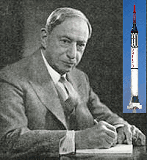 According
to the postscript to this editorial, Hugo Gernsback wrote his opinion on the then
current state of space exploration and his recommendation for how future efforts
should proceed, a month before Alan Shepherd made his historic suborbital flight
aboard the Freedom 7 Mercury capsule. That May 5, 1961, feat marked mankind's
first foray into space. Surprisingly, Gernsback was not in favor of a
manned space program. He believed the resources and expense required to support
human life in space would be better invested in developing autonomous and remotely
controlled robotic systems. Many people agreed with him then and today. Although
I do not oppose manned space flight, I tend to agree with Gernsback that much more
can be accomplished with machines than with humans. NASA's many successes on Mars
are evidence of the accomplishments possible with robots, and the long-term missions
possible. At some point it might be necessary to explore sending men to other planets,
but there really is no imperative at this time - just a desire to do so. Coincidentally
(or maybe not so coincidentally), Mr. Gernsback refers to his vision of a lunar
probe as "surveyor," which was name of NASA's series of robotic lunar lander probes
deployed...
According
to the postscript to this editorial, Hugo Gernsback wrote his opinion on the then
current state of space exploration and his recommendation for how future efforts
should proceed, a month before Alan Shepherd made his historic suborbital flight
aboard the Freedom 7 Mercury capsule. That May 5, 1961, feat marked mankind's
first foray into space. Surprisingly, Gernsback was not in favor of a
manned space program. He believed the resources and expense required to support
human life in space would be better invested in developing autonomous and remotely
controlled robotic systems. Many people agreed with him then and today. Although
I do not oppose manned space flight, I tend to agree with Gernsback that much more
can be accomplished with machines than with humans. NASA's many successes on Mars
are evidence of the accomplishments possible with robots, and the long-term missions
possible. At some point it might be necessary to explore sending men to other planets,
but there really is no imperative at this time - just a desire to do so. Coincidentally
(or maybe not so coincidentally), Mr. Gernsback refers to his vision of a lunar
probe as "surveyor," which was name of NASA's series of robotic lunar lander probes
deployed...
 When this detailed construction of the
Messerschmitt "Jaguar" bomber appeared in the October 1941 issue of Flying Aces
magazine, not many Americans suspected that within weeks the Japanese would bomb
Pearl Harbor and draw the country formally into World War II. That included
the other primary "Axis" power, Germany. Jaguars had been routinely dropping bombs
all over Europe for years. News of the increasing aggressiveness of Hitler's hoards
fill newspaper front pages and nightly news on radio (not many televisions at the
time), but that was "over there," not on our shores. Out of sight, out of mind,
as the saying goes. As with so many other areas of technology, the Germans were
very good aircraft designers and builders. The Jaguar was considered a medium range
bomber. It had a wingspan of 55 feet, similar to the De Havilland Mosquito
bomber with a 54 foot wingspan. By comparison, the Mitchell B−25 had a 67 foot wingspan...
When this detailed construction of the
Messerschmitt "Jaguar" bomber appeared in the October 1941 issue of Flying Aces
magazine, not many Americans suspected that within weeks the Japanese would bomb
Pearl Harbor and draw the country formally into World War II. That included
the other primary "Axis" power, Germany. Jaguars had been routinely dropping bombs
all over Europe for years. News of the increasing aggressiveness of Hitler's hoards
fill newspaper front pages and nightly news on radio (not many televisions at the
time), but that was "over there," not on our shores. Out of sight, out of mind,
as the saying goes. As with so many other areas of technology, the Germans were
very good aircraft designers and builders. The Jaguar was considered a medium range
bomber. It had a wingspan of 55 feet, similar to the De Havilland Mosquito
bomber with a 54 foot wingspan. By comparison, the Mitchell B−25 had a 67 foot wingspan...
 During World War II, Russia was considered
an ally, being part of the Allied forces battling the Axis powers. The Allied countries
were primarily the USA, England, the Soviet Union, China, and France. The Axis of
evil was primarily Germany, Japan, and Italy. Interesting, isn't it, that after
saving Russia from the Germans and China from the Japanese, they almost immediately
became our arch enemies, seeking to destroy the "Capitalist Pigs." Reportedly, Stalin
was originally to join with Hitler, but the two could not agree on how to share
power in the event of victory. Negotiations went awry after both countries invaded
Poland in 1939, which in spite of the Molotov–Ribbentrop Pact, effectively triggered
the beginning of World War II. For a deep dive into behind-the-scenes WWII
actions, be sure to watch the entire six season of Hogan's Heroes ;-)...
During World War II, Russia was considered
an ally, being part of the Allied forces battling the Axis powers. The Allied countries
were primarily the USA, England, the Soviet Union, China, and France. The Axis of
evil was primarily Germany, Japan, and Italy. Interesting, isn't it, that after
saving Russia from the Germans and China from the Japanese, they almost immediately
became our arch enemies, seeking to destroy the "Capitalist Pigs." Reportedly, Stalin
was originally to join with Hitler, but the two could not agree on how to share
power in the event of victory. Negotiations went awry after both countries invaded
Poland in 1939, which in spite of the Molotov–Ribbentrop Pact, effectively triggered
the beginning of World War II. For a deep dive into behind-the-scenes WWII
actions, be sure to watch the entire six season of Hogan's Heroes ;-)...
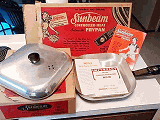 (add other photos) A nice vintage
Sunbeam Model FP−11A electric frypan, like one we had decades ago, showed up
at an estate sale. I plugged it in and it heated up quickly, so I paid the man $5
and brought it home. The magazine advertisement shown on the left is from 1956,
so it's more than sixty years old! Melanie and I have been on a mission for many
years to find Made in the USA products for use rather than support Red China. That
goes for appliances, tools, electronics, clothing, household goods, and whatever
else can be found. Before investing time into cleaning it up, I wanted to give it
a good going over. A quick check with the thermocouple showed that the temperature
was out of alignment with the dial. I removed the protective cover and found the
adjustment screw provided for setting the temperature. After a few iterations of
adjusting and measuring, I arrived at a place where the frypan would heat up to
about 20° degrees above the set point, turn off, then turn back on about 20° degrees
below...
(add other photos) A nice vintage
Sunbeam Model FP−11A electric frypan, like one we had decades ago, showed up
at an estate sale. I plugged it in and it heated up quickly, so I paid the man $5
and brought it home. The magazine advertisement shown on the left is from 1956,
so it's more than sixty years old! Melanie and I have been on a mission for many
years to find Made in the USA products for use rather than support Red China. That
goes for appliances, tools, electronics, clothing, household goods, and whatever
else can be found. Before investing time into cleaning it up, I wanted to give it
a good going over. A quick check with the thermocouple showed that the temperature
was out of alignment with the dial. I removed the protective cover and found the
adjustment screw provided for setting the temperature. After a few iterations of
adjusting and measuring, I arrived at a place where the frypan would heat up to
about 20° degrees above the set point, turn off, then turn back on about 20° degrees
below...
 "Imagine a world where science fiction meets
reality, where cutting-edge technology brings to life the awe-inspiring scenes from
movies like Prometheus. This is the groundbreaking research led by Dr. Fu Zhang,
at the University of Hong Kong (HKU), who has developed a
Powered-flying Ultra-underactuated LiDAR-Sensing Aerial Robot (PULSAR) that
is poised to redefine the world of unpiloted aerial vehicles (UAVs). UAVs are already
playing an increasingly vital role in search and rescue, cave surveying, and architectural
mapping. The PULSAR, aptly named for its similarities to an astronomical pulsar's
self-rotation and scanning pattern, takes UAV technology to new heights. With a
micro-computer and a LiDAR sensor, PULSAR boasts full onboard perception, mapping,
planning, and control capabilities in both indoor and outdoor environments, all
without requiring any external instruments. The secret to PULSAR's incredible functionality
lies in its single actuator, which powers the swashplateless..."
"Imagine a world where science fiction meets
reality, where cutting-edge technology brings to life the awe-inspiring scenes from
movies like Prometheus. This is the groundbreaking research led by Dr. Fu Zhang,
at the University of Hong Kong (HKU), who has developed a
Powered-flying Ultra-underactuated LiDAR-Sensing Aerial Robot (PULSAR) that
is poised to redefine the world of unpiloted aerial vehicles (UAVs). UAVs are already
playing an increasingly vital role in search and rescue, cave surveying, and architectural
mapping. The PULSAR, aptly named for its similarities to an astronomical pulsar's
self-rotation and scanning pattern, takes UAV technology to new heights. With a
micro-computer and a LiDAR sensor, PULSAR boasts full onboard perception, mapping,
planning, and control capabilities in both indoor and outdoor environments, all
without requiring any external instruments. The secret to PULSAR's incredible functionality
lies in its single actuator, which powers the swashplateless..."
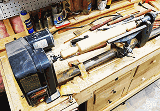 Melanie inherited a very old
rolling pin from her grandmother,
and at some point in our many household moves it either got lost or we gave it away.
It has been gone for many years. The one she has been using was bought at Kohl's
- nothing special. Unlike Melanie's grandmother's rolling pin which was turned from
a single piece of wood, including the handles, the replacement roller is on an axel
between separate handles. A couple years back I finally found a 12" Craftsman wood
lathe like the one I had bought soon after separating from the USAF in 1982, but
I sold it in 1992 prior to a cross-country move. A little over a year ago, we built
a house on our daughter and son-in-law's farm, and needed to cut down a couple very
large red oak and white oak trees. They were cut into 10-foot by 10" wide by 1"
thick fence boards and stacked to dry for a year. I chose some of the best examples
of boards and ran them through my Craftsman planer to have in store for future projects.
Window ledges were made for the house from some of it, and there were a lot of 1-1/2"
wide strips left over. I decided to laminate in alternate strips of red and white
oak. The contrast is not extreme like when using maple and walnut...
Melanie inherited a very old
rolling pin from her grandmother,
and at some point in our many household moves it either got lost or we gave it away.
It has been gone for many years. The one she has been using was bought at Kohl's
- nothing special. Unlike Melanie's grandmother's rolling pin which was turned from
a single piece of wood, including the handles, the replacement roller is on an axel
between separate handles. A couple years back I finally found a 12" Craftsman wood
lathe like the one I had bought soon after separating from the USAF in 1982, but
I sold it in 1992 prior to a cross-country move. A little over a year ago, we built
a house on our daughter and son-in-law's farm, and needed to cut down a couple very
large red oak and white oak trees. They were cut into 10-foot by 10" wide by 1"
thick fence boards and stacked to dry for a year. I chose some of the best examples
of boards and ran them through my Craftsman planer to have in store for future projects.
Window ledges were made for the house from some of it, and there were a lot of 1-1/2"
wide strips left over. I decided to laminate in alternate strips of red and white
oak. The contrast is not extreme like when using maple and walnut...
 In a time before massive overregulation
by the government, even starting your own car manufacturing business was a lot simpler.
In the early part of the 20th century there were dozens of independent car companies
that vied for the hard-earned money of a public growing increasingly demanding of
modern conveniences both in the home and outdoors. Unlike recent history where an
overreaching government decides who the winners (e.g., Chevrolet - aka Obama Motors)
and losers (e.g., Pontiac) are, market forces (i.e., the public) decided which companies
deserved to thrive and which deserved to push up corporate tulips. This "Auto Progress
Memory Lane" series of sketches by Douglas Rolfe, in a 1954 issue of Air Trails
magazine, gives you an idea of some of the early contenders...
In a time before massive overregulation
by the government, even starting your own car manufacturing business was a lot simpler.
In the early part of the 20th century there were dozens of independent car companies
that vied for the hard-earned money of a public growing increasingly demanding of
modern conveniences both in the home and outdoors. Unlike recent history where an
overreaching government decides who the winners (e.g., Chevrolet - aka Obama Motors)
and losers (e.g., Pontiac) are, market forces (i.e., the public) decided which companies
deserved to thrive and which deserved to push up corporate tulips. This "Auto Progress
Memory Lane" series of sketches by Douglas Rolfe, in a 1954 issue of Air Trails
magazine, gives you an idea of some of the early contenders...
 "Boeing engineers' handmade airplane shatters
a record by flying nearly the length of an American football field. It's a classic
activity everyone learns during their childhood. Fold a piece of paper into an airplane
and send it soaring into the sky with a flick of the wrist. Boeing engineers Dillon
Ruble and Garrett Jensen grew up
folding paper airplanes, but never thought they would one day break world records.
As second- and third-generation Boeing employees, Jensen and Ruble vividly remember
attending company Family Day events as children. "We would fold paper airplanes
back then as a fun childhood activity," Ruble said. "Origami, or the art of folding
paper, became a long-term passion." That passion ignited a dream, one that would
become record-breaking reality for the duo. "It was hard to believe..."
"Boeing engineers' handmade airplane shatters
a record by flying nearly the length of an American football field. It's a classic
activity everyone learns during their childhood. Fold a piece of paper into an airplane
and send it soaring into the sky with a flick of the wrist. Boeing engineers Dillon
Ruble and Garrett Jensen grew up
folding paper airplanes, but never thought they would one day break world records.
As second- and third-generation Boeing employees, Jensen and Ruble vividly remember
attending company Family Day events as children. "We would fold paper airplanes
back then as a fun childhood activity," Ruble said. "Origami, or the art of folding
paper, became a long-term passion." That passion ignited a dream, one that would
become record-breaking reality for the duo. "It was hard to believe..."
 A few years back, I wrote about the
Criterion RV−6 Dynascope, 6" Newtonian telescope I attempted to buy whilst serving
in the USAF at Robins AFB, Georgia, in from 1978-82. Now, half a decade later, I
finally found one at a reasonable price, where the owner was willing to pack and
ship it. He did an excellent job with it, and even used a harvy cardboard SonoTube
for protecting the optical tube. After performing a quick mirror alignment and using
the original Criterion eyepieces, I looked at the moon and Saturn and was amazed
at the quality of the image. A pert−near polar alignment was done and the clock
drive was turned on. With Siruis centered in the eyepiece to begin with, it was
still well within the field of view 20 minutes later. The success of those two tests
convinced me that undertaking a complete restoration would be worthwhile. The plan
is to remove all the original crakle type black and silver paint, sand and/or sandblast
the surfaces, then repaint as clost to original as possible. The green felt material
lining the main tube holder rings will be replaced with Teflon tape, which I already
have. The felt does not allow the tube to rotate easily, so hopefully the Teflon
will work out better...
A few years back, I wrote about the
Criterion RV−6 Dynascope, 6" Newtonian telescope I attempted to buy whilst serving
in the USAF at Robins AFB, Georgia, in from 1978-82. Now, half a decade later, I
finally found one at a reasonable price, where the owner was willing to pack and
ship it. He did an excellent job with it, and even used a harvy cardboard SonoTube
for protecting the optical tube. After performing a quick mirror alignment and using
the original Criterion eyepieces, I looked at the moon and Saturn and was amazed
at the quality of the image. A pert−near polar alignment was done and the clock
drive was turned on. With Siruis centered in the eyepiece to begin with, it was
still well within the field of view 20 minutes later. The success of those two tests
convinced me that undertaking a complete restoration would be worthwhile. The plan
is to remove all the original crakle type black and silver paint, sand and/or sandblast
the surfaces, then repaint as clost to original as possible. The green felt material
lining the main tube holder rings will be replaced with Teflon tape, which I already
have. The felt does not allow the tube to rotate easily, so hopefully the Teflon
will work out better...
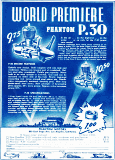 Little did most people know that two months
after this October 1941 issue of Flying Aces magazine arrived in their
mailboxes, the U.S. would be drawn into what would become World War II, following
the bombing of Pearl Harbor by the Japanese on December 7, 1941. Flying Aces
was chock full of factual and fictional stories about the last war (War War I),
and the things the Krauts and Nips were already pulling across Western Europe, North
Africa, China, and the South Pacific. Much more subject material was near at hand.
Oddly, the magazine changed its theme and title to Flying Age shortly before
the end of WWII, electing to focus more on full-scale aircraft rather than models.
According to the Bureau of Labor Statistics' Inflation Calculator, the $9.75 Phantom
P-30 engine would cost you about $194 in 2023. In 2020 it would have been $163.
That means the total rate of inflation for the last three (3) years has been around
19% (~6.3%/year). In 2016 the equivalent price would have been about $153, so from
2016 to 2020 the increase was just 6.5% for the entire four years (~1.6%/year)...
Little did most people know that two months
after this October 1941 issue of Flying Aces magazine arrived in their
mailboxes, the U.S. would be drawn into what would become World War II, following
the bombing of Pearl Harbor by the Japanese on December 7, 1941. Flying Aces
was chock full of factual and fictional stories about the last war (War War I),
and the things the Krauts and Nips were already pulling across Western Europe, North
Africa, China, and the South Pacific. Much more subject material was near at hand.
Oddly, the magazine changed its theme and title to Flying Age shortly before
the end of WWII, electing to focus more on full-scale aircraft rather than models.
According to the Bureau of Labor Statistics' Inflation Calculator, the $9.75 Phantom
P-30 engine would cost you about $194 in 2023. In 2020 it would have been $163.
That means the total rate of inflation for the last three (3) years has been around
19% (~6.3%/year). In 2016 the equivalent price would have been about $153, so from
2016 to 2020 the increase was just 6.5% for the entire four years (~1.6%/year)...
 Website visitor Wells S. just wrote asking
for another article to be posted - this time it is a very nice scale radio controlled
Spitfire IX. It appeared in
the February 1962 issue of American Modeler magazine published by the Academy
of Model Aeronautics (AMA). As was common in the era (1962), construction is very
robust and therefore heavy (10 pounds with a 64" wingspan). A Super Tigre .56 powered
the model in the article, and an Orbit radio with Bonner servos were used. My favorite
line in the article is, "In flight the Spitfire is very stable but snaps through
maneuvers and will tie knots in itself if you can operate transmitter switches fast
enough." We've come a long way, baby...
Website visitor Wells S. just wrote asking
for another article to be posted - this time it is a very nice scale radio controlled
Spitfire IX. It appeared in
the February 1962 issue of American Modeler magazine published by the Academy
of Model Aeronautics (AMA). As was common in the era (1962), construction is very
robust and therefore heavy (10 pounds with a 64" wingspan). A Super Tigre .56 powered
the model in the article, and an Orbit radio with Bonner servos were used. My favorite
line in the article is, "In flight the Spitfire is very stable but snaps through
maneuvers and will tie knots in itself if you can operate transmitter switches fast
enough." We've come a long way, baby...
 When did "Model Rocketry" morph into "Space
Models?" I missed that important milestone. Everything on those tables look like
rockets to me. Maybe the term "rocket" sounds too military... or too White. Bureaucrats
ruin everything. "The
2023 FAI S World Championships
for Space Models have officially kicked off! With over 200 competitors from
17 different countries, this exciting large scale FAI event is taking place in Austin,
Texas, USA from Sunday, 2 July, to Friday, 7 July." That was last week, but there
are not many photos posted yet of the flying phase of the competition. The National
Association of Rocketry, the Academy of Model Aeronautics and the National Aeronautic
Association organized and conducted the event...
When did "Model Rocketry" morph into "Space
Models?" I missed that important milestone. Everything on those tables look like
rockets to me. Maybe the term "rocket" sounds too military... or too White. Bureaucrats
ruin everything. "The
2023 FAI S World Championships
for Space Models have officially kicked off! With over 200 competitors from
17 different countries, this exciting large scale FAI event is taking place in Austin,
Texas, USA from Sunday, 2 July, to Friday, 7 July." That was last week, but there
are not many photos posted yet of the flying phase of the competition. The National
Association of Rocketry, the Academy of Model Aeronautics and the National Aeronautic
Association organized and conducted the event...